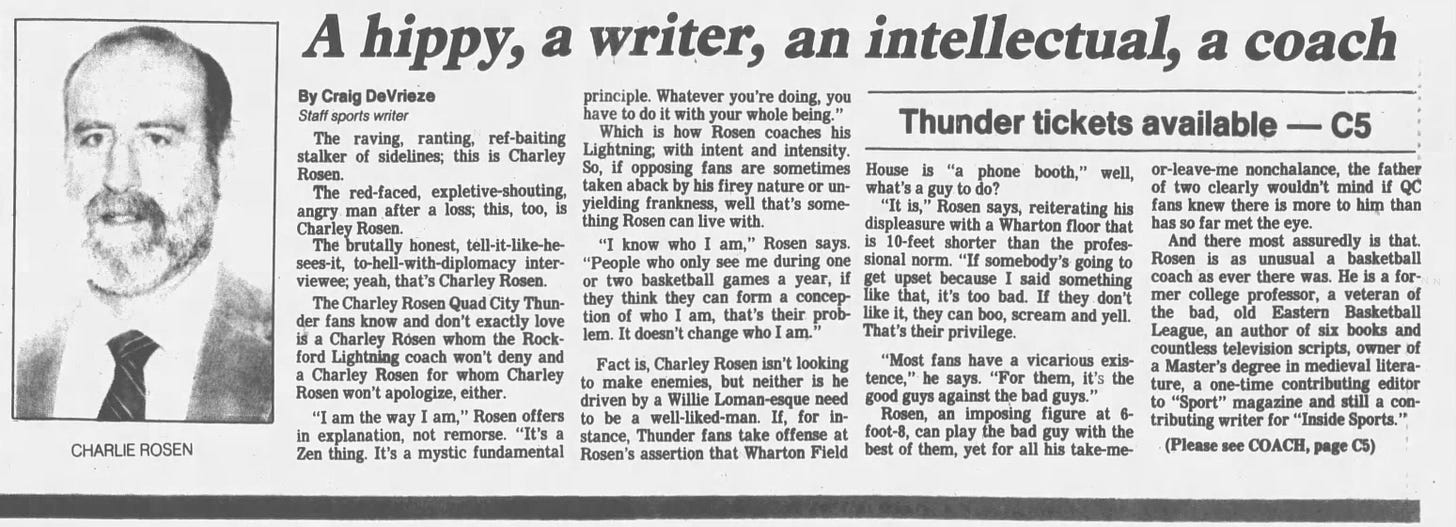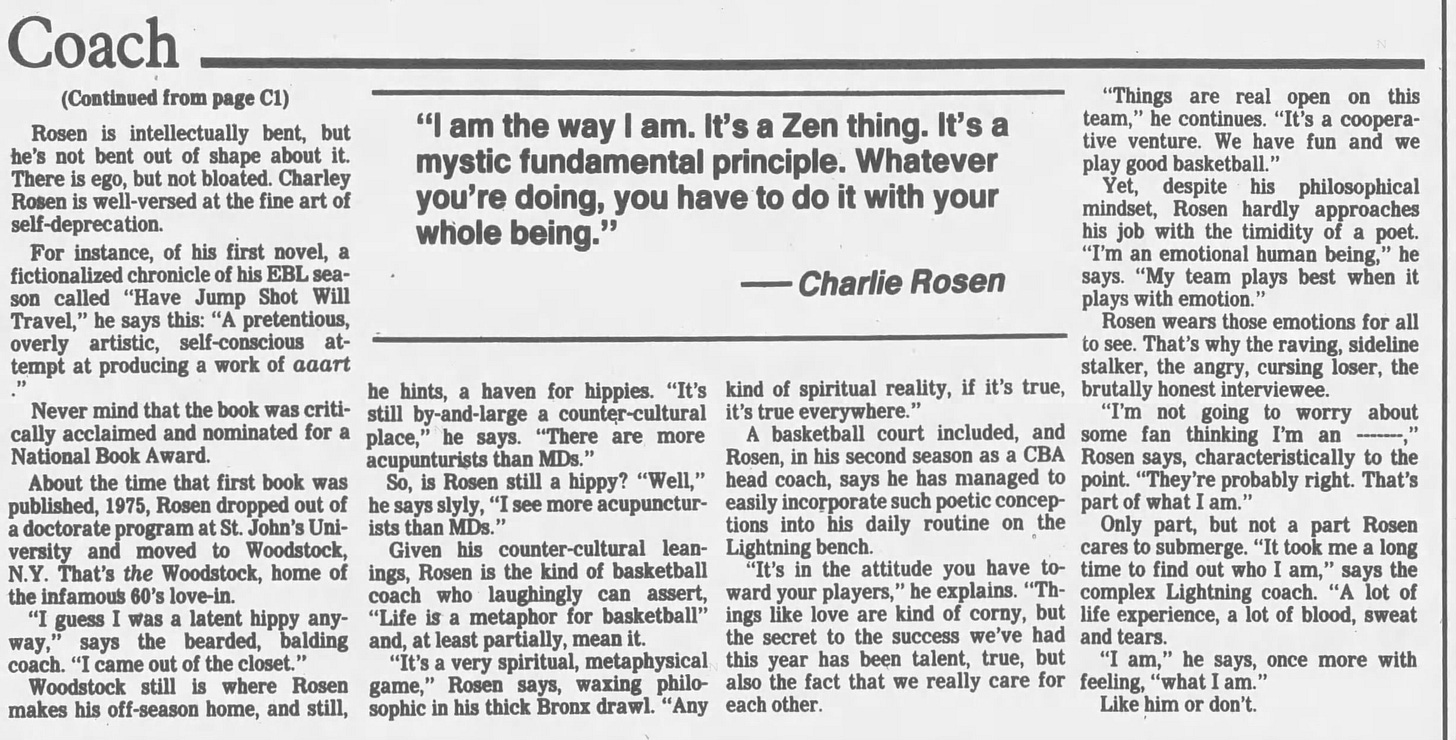Remembering Charley: A Basketball Life Well-Lived
Online obituaries are describing Charley Rosen as “a basketball lifer,” and that’s not entirely out of bounds.
To a man, that’s a fitting epitaph for any member of the wonderfully colorful cast of Continental Basketball Association coaches who came first through Wharton Field House — the place Rosen memorably rechristened The Phone Booth — and later The Mark of the Quad Cities during our halcyon days of the late, great Quad City Thunder.
Flip Saunders. George Karl. Eric and Bill Musselman. Rick Barry. Cazzie Russell. Mo McHone. Keith Smart. Henry Bibby. Sonny Allen. Dennis Johnson. Brendan Suhr. Bill Klucas. John Treloar. Mike Thibault. And, of course, the Thunder’s own Mauro and Dan Panaggio.
Many of the above came from and/or went on to the National Basketball Association. That was the CBA’s reason for being for players and for coaches. Others did not reach that Holy Grail, and that is where the CBA’s story truly lived, in the margins between success and failure for all the basketball lifers whose mission was making the Show.
Charley Rosen stood apart from his fellow basketball lifers in that he didn’t just live that story; he got that story. He loved the story. He told the story.
Beyond the sidelines, Charley spent a lifetime writing about basketball with the lyrical sensibilities of a poet. Starting with “Have Jump Shot Will Travel,” a fictionalized telling of his experience in the CBA forerunner, the Eastern Basketball League, Charley wrote in the margins, colored outside the lines, of the pro game’s far less glamorous, but often more interesting sideshow.
More than a decade after its publication in 1975, Charley would describe that first novel as “a pretentious, overly artistic, self-conscious attempt at producing a work of aaart.”
He never stopped attempting to capture the spirit of what he called “a very spiritual, metaphysical game,” authoring 15 more books about basketball, including two — “The House of Moses All-Stars” (1996) and “Barney Polan’s Game” (1998) — that were recommended reading by The New York Times Book Review.
His most well-read effort was published concurrently with “Have Jump Shot Will Travel,” and ultimately provided his on-ramp to professional coaching. He co-authored “Maverick: More Than a Game” with fellow basketball poet Phil Jackson in 1975, starting a lifelong friendship with the former New York Knicks standout who would later launch his own legendary coaching career with the Albany Patroons of the CBA. Charley spent three seasons as Jackson’s Patroons assistant from 1983-1986, then took the helm of the Savannah Spirits in 1986, the first of his six seasons as one of the most colorfully combustible head coaches to ever stalk a CBA sideline.
Most memorably for Quad Cities basketball fans, Charley was the literal lightning in the epic Thunder-Lightning rivalry, starting in the Thunder’s debut season in 1987-1988. In advance of a contentious seven-game, first-round playoff series won by Rosen’s Rockford club, he answered my too-simple question, “Looking forward to coming back to Wharton Field House?” with an infamously flip response, “You mean the phone booth?”
That reference to the field house’s 10-feet shy of professional regulation floor left Charley hearing bells with every return to the QCs. Through his final season at the Lightning helm in 1990, any pause in the action was likely to be greeted with the familiar ring-aling of a telephone, and the sell-out crowds took glee in calling out, “Charley, it’s for you.”
Because he got it, Charley never minded playing the foil in the long-running gag, but he never played the fool. He well understood his ref-baiting, tempestuous sideline demeanor often carried him past the point of reason, but, in quieter moments, beyond the sideline, he was philosophical about it all.
“I’m not going to worry about some fan thinking I’m an asshole,” he told me for a feature story before that 1988 playoff series. “They’re probably right. That’s part of what I am.”
But he was so much more than that. And much, much more than the typical basketball lifer. Charley never followed better-known contemporaries like Saunders, Karl, and Eric Musselman to head coaching assignments in the NBA. He moved from Rockford to single seasons on the CBA sidelines in Oklahoma City and back with the Patroons, and later spent two seasons as head coach of the women’s team at the State University of New York-New Paltz from 1993 to 1995.
His final years as a basketball lifer were spent chronicling the professional and college game for websites like FoxSports.com and HoopsHype.com. He penned a dozen more books, including biographies of Darryl Dawkins, Earl Monroe, and Michael Ray Richardson, and further explored life on the margins of basketball, as seen in “Crazy Basketball: A Life In and Out of Bounds” (2011). In 1992, as his time on the CBA sidelines was coming to an end, he wrote “The Cockroach Basketball League,” a fictional account of his experiences in the league. Therein, a careful reader could infer references to real-life friends and foes, a few from those wild Thunder-Lightning encounters.
I spoke with Charley a few times after our own shared experiences as a reporter and a subject came to an end, once over dinner where he shared his counsel on the art of writing books, and most recently in a quick phone call in which he wondered about the feasibility of resurrecting old CBA rivalries, including with a team that would play in the old phone booth of all places.
We also became friends on Facebook, and it was there that his daughter shared news of Charley’s death this past Saturday at the age of 82.
Sad news, but a happy opportunity to reflect on a life well-lived by a “basketball lifer” who was that and so much more.
“I am the way I am,” Charley unapologetically told me in 1988. “It’s a Zen thing. It’s a mystic, fundamental principle. Whatever you’re doing, you have to do it with your whole being.”
That, Charley Rosen did. No better epitaph than that.
Charley Rosen Inducted Into NYC Basketball Hall of Fame 2024




